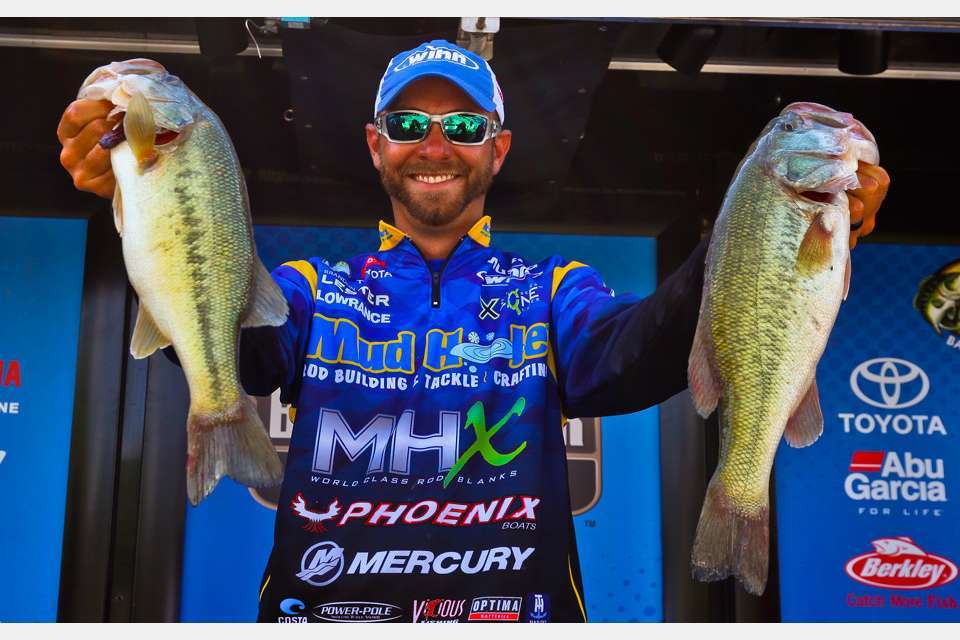
Tennessee native Brandon Lester calls out Lake Chickamauga as a personal favorite for two reasons. The bass grow big, and they are plentiful.
“It’s just so darn good because of the Florida largemouth stocked by our state fisheries agency,” he said. “That is why there are so many 10-pound-plus bass caught all year, and it’s just such a fertile lake.”
Lester knows a thing or two about critiquing bass lakes. As a Bassmaster Elite Series pro, he competes in a league that is built around fishing the nation’s best big bass lakes. Back home in Tennessee, he comes to Chickamauga to stay tuned up for the tour.
Chickamauga produced the current state record largemouth weighing 15.20 pounds. The Tennessee Wildlife Resources Agency began stocking Florida-strain largemouth in 2000 to boost the average size of the bass population. Size and catch rates have been on the increase ever since, and so has Chickamauga’s notoriety as one of the nation’s top trophy bass lakes. It ranks sixth on the 2019 Bassmaster Magazine Top 100 Bass Lakes rankings.
Just when you might think trophy bass season winds down after two seasons worth of hot action, that is not so at Chickamauga. The action carries on through fall as the largemouth bulk up for winter on the lake’s abundance of forage bait, including threadfin and gizzard shad.
About that same time, Lester’s tournament season wraps up, and you will find him enjoying the rod-bending action of catching big largemouth using a technique that causes heartbeat skipping reactions from bass anglers.
“When I think of Chickamauga in fall, I think of two things, and those are flipping and frogging in heavy vegetation,” he said. “Those are the two predominant patterns that visitors can count on for catching big bass.”
He added, “You have to try both to see which is most productive at the time.”
Who could complain about having to do that? No one. Here’s how he goes about that process.
Lester recommends beginning the search on the lower lake, between Chester Frost Park and the TVA Sequoyah Nuclear Plant. The drawing card there is large expanses of aquatic vegetation that spread across vast shallow flats and channel drops. The grass provides ambush cover for the bass as bait swim past.
“Cruise along those areas and look for the most heavily matted grassbeds, and mark waypoints as you go,” said Lester. “Don’t count anything out, shallow or deep, because the fish are in transition.”
He continued, “You’ve got fish coming off the river, they live in giant schools out there, and they migrate to the backs of creeks and chase bait.”
With areas identified, Lester brings out the frog, casting it along grass edges and retrieving it across the vegetation.
“The denser the better because when you pull the frog over the thick, dying grass it creates a disturbance below that gets their attention,” he explained.
The good news for this pattern is where there is one there are more bass.
“Work an area thoroughly after you catch one, because they do gang up to feed in those areas.”
By October the milfoil begins to die off, making it the most ideal grass for frogging. Hydrilla has a longer growing season because of its deeper origins. Lester recommends frogging in the shallower growing milfoil, and using his other preferred pattern in the deeper rooted hydrilla.
“Punching mats is that pattern, and because depth is more important, look for hydrilla growing on points, channel bends, ditches and any other bottom contour irregularities.”
Count mixed varieties of grass among those irregularities. Punch the bait through the thick grass growing over and around the depth contours as described by Lester.
“it gets better as the water cools off,” said Lester. “And you can’t beat the cool fall weather and the colors as the leaves turn.”
Gear up: For frogging rig up with a Spro Dean Rojas Bronzeye Frog 65, Natural Red, with 50-pound Vicious No Fade Braid. Lester makes his own rods using components from Mud Hole Custom Tackle. “You need a stout rod to get fighting fish out of the grass.” He does battle with a self-made 7′ 9″ extra heavy action MHX Rod. Using the same rod, and 60-pound Vicious No Fade Braid, he ties on a 4/0 Mustad Denny Brauer Grip-Pin Max Flippin’ hook, rigged with a 1.5-ounce tungsten weight. Completing the punch rig is an X Zone Muscle Back Craw.
About the lake: Lake Chickamauga stretches 59 miles on the Tennessee River from Watts Bar Dam, southwest of Knoxville, to Chickamauga Dam in Chattanooga. The lake has 810 miles of shoreline with a surface area covering 36,240 acres. The Hiwassee River empties into Chickamauga on the lower end of the lake.
Other fun: The lake’s close proximity to Chattanooga make it an ideal basecamp for enjoying numerous fall festivals. Ruby Falls is the country’s largest underground waterfall, and Chickamauga and Chattanooga National Military Park is the largest of its kind in the nation. The Lookout Mountain Incline Railway is one of the steepest incline railways in the world, and while at the top you can see seven states from Rock City. Don’t miss a trip to the Tennessee Aquarium, home to Ocean Journey and River Journey, which is 130,000 square feet and tall as a 12-story building. Inside are 400,000 gallons that trace the theme of a river, from a raindrop high in the Appalachians to the Gulf of Mexico.
Plan your trip:tnvacation.com





